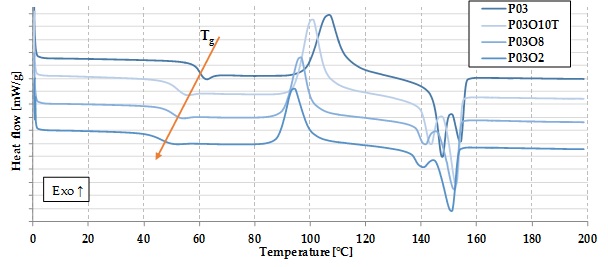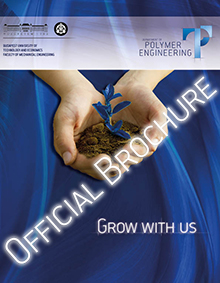Development of a value-added, multifunctional biopolymer packaging system and production technology
Dr. Ákos Kmetty
Dr. Kornél Pölöskei
Dr. Bálint Morlin
Dr. Dániel Gere
Dr. Márton Tomin
Dr. Katalin Litauszki
Dr. Norbert Krisztián Kovács
Dr. Roland Petrény
Dr. Sándor Hajba
Dr. Gábor Szebényi
Dr. Brigitta Bodzay
Katalin Bordácsné Dr. Bocz
Tamás Igricz
Dr. György Marosi
Dr. Beáta Szolnoki
Dániel Vadas
Polifoam Műanyagfeldolgozó Kft.
Project summary
The goal of the project is to develop new, multifunctional biopolymer-based packaging systems, and design their controlled manufacturing technology. In the project we will do a wide range of basic research (e.g. softening, increasing thermal stability, strengthening) to modify the properties of polylactic acid (PLA) in order to make them easier to adjust flexibly and controllably according to the requirements (e.g. distribution of molecular weight, crystallinity, processing window, strength, stiffness etc.) of innovative packaging applications. We plan to make multifunctional packaging materials from the developed biopolymer types, first making sheets, then performing thermoforming and foaming.
Project results

Project-related publications
- Litauszki K., Petrény R., Haramia Zs., Mészáros L.: Combined effects of plasticizers and D-lactide content on the mechanical and morphological behavior of polylactic acid. Heliyon, 9, e14674/1-e14674/9 (2023) 10.1016/j.heliyon.2023.e14674 IF=3.4 Q1
- Litauszki K., Kmetty Á.: Tejsav oligomerrel lágyított, politejsav-alapú biopolimer habok előállítása. Acta Materialia Transylvanica, 4, 32-37 (2021) 10.33923/amt-2021-01-06
- Litauszki K., Kmetty Á.: Investigation of the damping properties of polylactic acid-based syntactic foam structures. Polymer Testing, 103, 107347 (2021) 10.1016/j.polymertesting.2021.107347 IF=4.931 D1
- Litauszki K.: Buborékos biopolimer-szerkezetek. Élet és Tudomány, 76, 240-242 (2021)
- Horváth A., Petrény R., Mészáros L.: Elektromosan vezetőképes politejsav mátrixú hibridkompozit fejlesztése. in 'XXIX. Nemzetközi Gépészeti Konferencia (OGÉT 2021) Románia. 2021.04.23.,114-117 (2021)
- Morlin B., Litauszki K., Petrény R., Kmetty Á., Mészáros L.: Characterization of polylactic acid-based nanocomposite foams with supercritical CO2. Measurement, 178, 109385/1-109385/6 (2021) 10.1016/j.measurement.2021.109385 IF=5.131 Q1
- Peter T., Litauszki K., Kmetty Á.: Improving the heat deflection temperature of poly(lactic acid) foams by annealing. Polymer Degradation and Stability, 190, 109646 (2021) 10.1016/j.polymdegradstab.2021.109646 IF=5.204 Q1
- Pölöskei K., Csézi G., Hajba S., Tábi T.: Investigation of the thermoformability of various D-Lactide content Poly(Lactic Acid) films by ball burst test. Polymer Engineering and Science, 60, 1266-1277 (2020) 10.1002/pen.25378 IF=2.428 Q3
- Bocz K., Szolnoki B., Farkas A., Verret E., Vadas D., Decsov K., Marosi Gy.: Optimal distribution of phosphorus compounds in multi-layered natural fabric reinforced biocomposit. Express Polymer Letters, 14, 606-618 (2020) 10.3144/expresspolymlett.2020.50 IF=4.161 Q1
- Litauszki K., Kmetty Á.: Characterization of chemically foamed poly(lactic acid). IOP Conference Series: Materials Science and Engineering, 903, 012018/1-012018/7 (2020) 10.1088/1757-899X/903/1/012018
- Gere D., Czigány T.: Future trends of plastic bottle recycling: Compatibilization of PET and PLA. Polymer Testing, 81, 106160/1-106160/10 (2020) 10.1016/j.polymertesting.2019.106160 IF=4.282 Q1
- Tábi T., Csézi G., Kovács N. K.: 3D nyomtatott biokompozit vázszerkezetű fröccsöntött termékek vizsgálata. Polimerek, 6, 1042-1046 (2020)
- Kmetty Á., Litauszki K.: Development of poly(lactide acid) foams with thermally expandable microspheres. Polymers, 12, 16 (2020) 10.3390/polym12020463 IF=4.329 Q1
- Litauszki K., Kmetty Á.: Politejsav kémiai habképzésének lehetőségei exoterm és endoterm típusú habképzőszerek alkalmazásával. Polimerek, 6, 1138-1142 (2020)
- Petrovszki D., Litauszki K., Mészáros L.: A szilárd fázisú polikondenzáció hatása a politejsav kristályos tulajdonságaira. Polimerek, 6, 829-833 (2020)
- Vadas D., Nagy Zs. K., Csontos I., Marosi Gy., Bocz K.: Effects of thermal annealing and solvent-induced crystallization on the structure and properties of poly(lactic acid) microfibres produced by high-speed electrospinning. Journal of Thermal Analysis and Calorimetry, 142, 581–594 (2020) 10.1007/s10973-019-09191-8 IF=4.626 Q1
- Bocz K., Molnár B., Marosi Gy., Ronkay F.: Preparation of Low-Density Microcellular Foams from Recycled PET Modified by Solid State Polymerization and Chain Extension. Journal of Polymers and the Environment, 27, 343-351 (2019) 10.1007/s10924-018-1351-z IF=2.572 Q2
- Litauszki K., Kovács Zs., Mészáros L., Kmetty Á.: Accelerated photodegradation of poly(lactic acid) with weathering test chamber and laser exposure – A comparative study. Polymer Testing, 76, 411-419 (2019) 10.1016/j.polymertesting.2019.03.038 IF=3.275 Q1
- Decsov K., Bocz K., Szolnoki B., Bourbigot S., Fontaine G., Vadas D., Marosi Gy.: Development of Bioepoxy Resin Microencapsulated Ammonium-Polyphosphate for Flame Retardancy of Polylactic Acid. Molecules, 24, 4123/1-4123/23 (2019) 10.3390/molecules24224123 IF=3.267 Q2
- Hajba S., Tábi T.: Cross effect of natural rubber and annealing on the properties of poly(lactic acid). Periodica Polytechnica-Mechanical Engineering, 63, 270-277 (2019) 10.3311/PPme.12825
- Tábi T.: The application of the synergistic effect between the crystal structure of Poly(Lactic Acid) (PLA) and the presence of Ethylene Vinyl Acetate copolymer (EVA) to produce highly ductile PLA/EVA blends. Journal of Thermal Analysis and Calorimetry, 138, 1287-1297 (2019) 10.1007/s10973-019-08184-x IF=2.731 Q2
- Litauszki K., Kmetty Á.: Extrusion Foaming of Poly(Lactic Acid) with Thermally Expandable Microspheres. in 'SPE Foams 2019 Valladolid, Spanyolország. 2019.10.02.-10.03.,1-5 (2019)
- Gere D., Czigány T.: Recycling of Mixed Poly(Ethylene-terephthalate) and Poly(Lactic Acid). in '2018 International Conference on Materials Science and Manufacturing Engineering (MSME 2018) Párizs, Franciaország. 2018.11.08-10.,6 (2019)
- Gonda B., Mészáros L.: A hőkezelés tulajdonságmódosító hatása bazaltszál erősítésű politejsav kompozit esetében. in 'OGÉT 2018: XXVI. Nemzetközi Gépészeti Konferencia: 26th International Conference on Mechanical Engin Marosvásárhely, Románia. 2018.04.26-2018.04.29.,147-150 (2018)
- Litauszki K., Kmetty Á., Bárány T.: Politejsav alapú bio-habok fejlesztése expandálható mikrokapszula felhasználásával. Polimerek, 4, 316-321 (2018)
- Kmetty Á., Litauszki K.: Characterisation of Poly(lactic Acid) Foams produced by extrusion with different chemical blowing agents. in '4th Edition of International Conference on Polymer Science and Technology London, Egyesült Királyság. 2018.06.04-2018.06.05, (2018)
- Marosi Gy., Hirsch E., Bocz K., Toldy A., Szolnoki B., Bodzay B., Csontos I., Farkas A., Balogh A., Démuth B., Nagy Z., Pataki H.: Pharmaceutical and macromolecular technologies in the spirit of industry 4.0. Periodica Polytechnica-Chemical Engineering, 64, 4 (2018) 10.3311/PPch.12870 IF=1.382 Q3
- Hajba S., Tábi T.: Investigation of long cellulose fibre reinforced and injection moulded Poly(lactic acid) biocomposites. Acta Technica Jaurinensis, 11, 150-164 (2018) 10.14513/actatechjaur.v11.n3.469
- Vadas D., Kmetykó D., Marosi Gy., Bocz K.: Application of melt-blown poly(lactic acid) fibres in self-reinforced composites. Polymers, 10, 1-12 (2018) 10.3390/polym10070766 IF=3.164 Q1
- Gere D., Czigány T.: Rheological and mechanical properties of recycled polyethylene films contaminated by biopolymer. Waste Management, 76, 190-198 (2018) 10.1016/j.wasman.2018.02.045 IF=5.431 Q1
- Tábi T., Wacha A. F., Hajba S.: Effect of D-Lactide content of annealed Poly(lactic acid) on its thermal, mechanical, heat deflection temperature, and creep properties. Journal of Applied Polymer Science, 135, 47103/1-47103/10 (2018) 10.1002/app.47103 IF=2.188 Q2
- Bocz K., Decsov K. E., Farkas A., Vadas D., Bárány T., Wacha A. F., Bóta A., Marosi Gy.: Non-destructive characterisation of all-polypropylene composites using small angle X-ray scattering and polarized Raman spectroscopy. Composites Part A: Applied Science and Manufacturing, 114, 250-257 (2018) 10.1016/j.compositesa.2018.08.020 IF=6.282 D1
- Gonda B., Mészáros L.: A bazaltszál és a montmorillonit jelenlétének hatása a politejsav termomechanikai tulajdonságaira. Polimerek, 4, 285-289 (2018)
- Hajba S., Tábi T.: Gócképzők hatása a politejsav tulajdonságaira. Polimerek, 4, 387-390 (2018)
- Kmetty Á., Litauszki K., Réti D.: Characterization of different chemical blowing agents and their applicability to produce poly(lactic acid) foams by extrusion. Applied Sciences-Basel, 8, 1-17 (2018) 10.3390/app8101960 IF=2.217 Q2
- Kiss Z., Temesi T., Czigány T.: Adherability and weldability of poly(lactic acid) and basalt fibre-reinforced poly(lactic acid). Journal of Adhesion Science and Technology, 32, 173-184 (2018) 10.1080/01694243.2017.1349716 IF=1.21 Q3
- Vadas D., Igricz T., Sarazin J., Bourbigot S., Marosi Gy., Bocz K.: Flame retardancy of microcellular poly(lactic acid) foams prepared by supercritical CO2-assisted extrusion. Polymer Degradation and Stability, 153, 100-108 (2018) 10.1016/j.polymdegradstab.2018.04.021 IF=3.78 Q1
- Mészáros L., Gonda B.: Development of basalt fibre and montmorillonite nanoparticle co-reinforced poly(lactic-acid) matrix hybrid composites. in '9th International Conference on Nanomaterials - Research and Application, NANOCON 2017 Brno, Csehország. 2017.10.18-2017.10.20.,212-217 (2018)
- Litauszki K., Kmetty Á.: Development and characterization of innovative biopolymer foams. IOP Conference Series: Materials Science and Engineering, 426, 1-8 (2018) 10.1088/1757-899X/426/1/012031
- Vadas D., Kmetty Á., Bárány T., Marosi G., Bocz K.: Flame retarded self-reinforced polypropylene composites prepared by injection moulding. Polymers for Advanced Technologies, 29, 433-441 (2018) 10.1002/pat.4132 IF=2.162 Q2
- Vadas D., Kmetykó D., Szabó B., Marosi Gy., Bocz K.: Ömledékfúvással gyártott mikroszálak felhasználása önerősített politejsav kompozitok előállítására. Polimerek, 4, 245-250 (2018)
- Vadas D., Bocz K., Igricz T., Tábi T., Szabó B., Marosi Gy.: Égésgátolt politejsav habok előállítása szuperkritikus szén-dioxiddal segített extruzióval. Polimerek, 3, 156-160 (2017)






